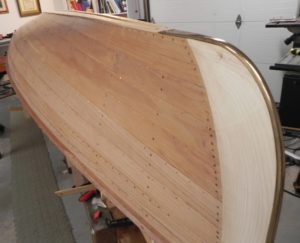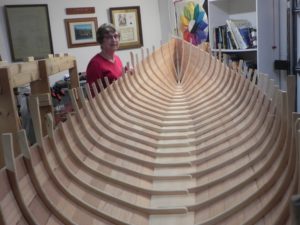When it came time to take my latest guideboat off the builder’s gig I was full of apprehension. It meant lifting the boat up a ways and flipping it over so it is right side up. I wasn’t sure how far we would have to lift the boat to clear the jig. My old workshop had plenty of headroom but this latest was a converted garage in the basement. There is not a lot of clearance in the new shop. Here she is still on the builder’s jig.

Anyway, I set up padded saw horses next to the boat and asked my wife Fran if she would take one end of the boat, and I the other, and we would give lifting it off a try ( I didn’t know what we would do if we got stuck with it halfway off.)
I think I told her that it would be all right if we let it rest sideways on the gunwale while getting it off the jig. In our favor the boat does not weigh very much at this stage, at the most 60 pounds. So off we go! Now Fran is a strong woman but on the short side. The boat slid upwards easily but the problem arose in turning it over. I heard an anguished shriek from the other end. Fran yelled “My heads caught inside the boat!” What to do? I can’t leave my end. I said “Drop it down on the gunwale, it can take it”. She did, and the crisis ended.
There was suspense on my part about seeing the inside of the boat for the first time. Some of the old time builders had a rotisserie-type builder’s gig that allowed them to spin the nascent hull around to view both sides while they were in the midst of planking. I had no such luxury.
My first view of my baby guideboat was breathtaking. She was beautiful! She brought a tear to my eye. Here she is with Fran next to her.

Before we took baby guideboat off the jig I gave her two coats of Epiphanes wood finish gloss marine spar varnish on the outside of the hull. That brought out the amazing beauty of the Spanish cedar she is made of. I’ll talk about that in another post.
So it occurred to me that a guideboat has two important days in its life. The first is when it is “born”. For me that is when it comes off the builder’s jig. It is the first time anyone has seen the inside of the hull. Of course you can scrunch down and look under the upside down hull or use a mirror to take a peek. But that is not the same as seeing her right side up for the first time. Again, breathtaking! All the worries about “What kind of job did I do under there” dissipate.
The second important day is launch day. That is the day she first encounters her reason for being, to float with her friend/friends aboard. She is now clothed for the occasion, with guideboat furniture installed, oars and oar locks in play, and fancy decks that hide the handles for lifting her over Adirondack carries.
By the way, I weighed her using a bathroom scale. She came in at 60 lbs. That is quite good considering that she already has two coats of varnish on the outside of the hull.
There is film of Willard Hanmer building a guideboat that plays over and over again in the boat shop wing of the Adirondack museum. When he takes his boat off the builder’s jig, the narrator, Carl Hathaway, proclaims that Willard is “just about half done”. I hope I am further along than that but there is still much work to be done.
Next time we step back and see how the hull was varnished.